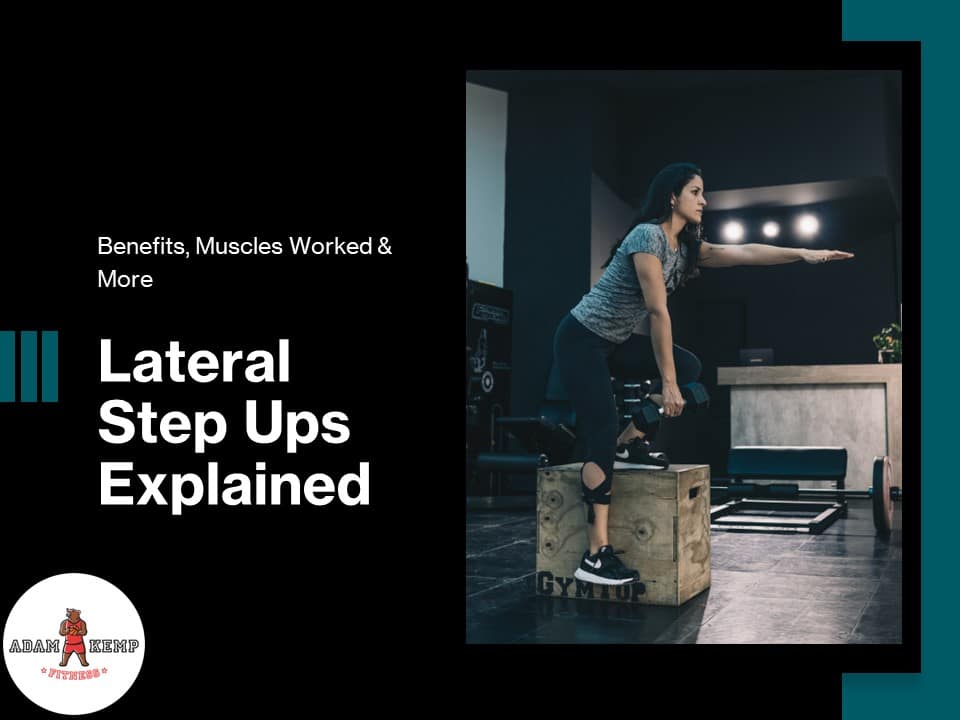Lateral Step Ups (Side Step Ups): Benefits, Muscles Worked
Lateral step-ups are a variation of the traditional step-up exercise, which involves stepping onto a bench or box sideways rather than forward, adding an extra layer of challenge to your workout.
The step-up exercise is widely recognized as one of the most effective leg exercises, offering an accessible learning curve compared to exercises such as squats, deadlifts, or Bulgarian split squats.
Despite requiring balance control, step-ups generally aren’t significantly more challenging than ascending a flight of stairs.
To increase the intensity of your workout, consider trying lateral step-ups!
Although lateral step-ups aren’t performed much differently than traditional step-ups, they are a different exercise with different benefits.
By altering your movement direction from forward to sideways, lateral step-ups add a unique layer of complexity to the exercise.
This shift not only amplifies balance and control demands but also emulates real-world movements, thereby boosting your functional fitness.
What is the Lateral Step Up Exercise?
The lateral step-up is a lower-body strength and stability exercise that involves stepping sideways onto a raised surface, such as a bench or box.
Unlike traditional step-ups, which focus on vertical movement, this variation incorporates a lateral component, challenging balance, coordination, and muscle activation in a unique way.
This exercise mimics real-life lateral movements and sports-specific actions, making it highly functional for athletes and fitness enthusiasts alike.
By engaging muscles from a different angle, it strengthens underutilized stabilizers, enhances joint health, and contributes to overall athleticism.
Lateral Step Ups Muscles Worked
Lateral step-ups are an effective lower-body exercise that targets multiple muscle groups, offering both strength and stability benefits.
For example, research indicates that lateral step-ups elicit significantly greater activation of the rectus femoris and vastus medialis muscles compared to stepping machine exercises, highlighting their effectiveness for strengthening key lower-body muscles.
By incorporating lateral movement, this variation activates muscles that traditional step-ups might miss, making it a valuable addition to any workout routine.
Here’s a breakdown of the primary and secondary muscles engaged during this exercise.
- Quadriceps: This group of muscles at the front of your thigh is instrumental in extending the knee during the stepping-up movement.
- Glutes: These are the powerhouse muscles in your buttocks that drive your hip extension when you step up and help maintain your balance.
- Hamstrings: Located at the back of your thigh, these muscles work in tandem with your glutes to support hip extension and control the lowering phase of the step-up.
- Calves: These muscles are key for stabilizing your ankle throughout the movement, especially when you push off from the ground.
- Rectus Abdominis: Your ‘six-pack’ muscle, this supports your spine and helps maintain a steady and upright posture throughout the exercise.
- Transverse Abdominis: This deep abdominal muscle contributes significantly to your core stability, helping you maintain balance during the lateral step-up.
- Obliques: These side abdominal muscles are engaged to stabilize your torso and assist with balance as you step sideways onto the platform.
How to Do Lateral Step Ups
Generally speaking, the lateral step-up is a simple single-leg exercise. Here is a quick exercise demonstration and a step-by-step guide below:
- Step 1.) Position Yourself: Stand beside a sturdy bench or box with your feet shoulder-width apart. Keep your posture upright and engage your core.
- Step 2.) Place Your Foot: Lift the foot closest to the bench and place it firmly on the surface. The other foot stays on the ground.
- Step 3.) Step Up: Push through the heel of the foot on the bench to lift your body. Focus on using the leg on the bench, not the one on the ground.
- Step 4.) Balance: At the top, both legs should be straight. Hold briefly, keeping your chest up and core engaged.
- Step 5: Step Down: Lower yourself slowly with control, keeping your foot on the bench in place. Repeat the movement on the other side for balance.
Now you know how to do lateral step ups!
How to Add Lateral Step-Ups to Your Workout Program
Lateral step-ups are a great assistance exercise that you can do on both lower-body and full-body workout days.
You might be wondering: should I replace conventional step-ups with lateral ones?
From my experience, having both in your workout routine gives you the best of both worlds, as they’re unique exercises with distinctive benefits.
For example, research indicates that although lateral step-ups are highly effective for quadriceps engagement, they may not generate significant increases in peak power or thigh-muscle development in short-term protocols, emphasizing their utility for functional movement over hypertrophy.
Let me share how I usually incorporate lateral step-ups into my regimen:
Sets & Reps
You can use several different sets and rep ranges for lateral step-ups.
One option is to do your lateral step-ups at the beginning of your workout to activate your lower body and core muscles, using higher sets and reps such as four sets of 20 reps.
I normally choose this option, and I feel like it is an especially great exercise before lower-body intensive workout days, such as when I do 20 rep squats.
After doing my lateral step-ups, my knees and hips are always completely warmed up and activated for heavier exercises.
However, if you want to use this exercise towards the end of your workout, feel free to add more weight and lower reps. For example, you could do three sets of 5 reps (on each leg) with heavy dumbbells or kettlebells.
Although you can use a barbell to add weight to this exercise, I prefer dumbbells or kettlebells because it puts less pressure on your spine and it helps develop grip strength.
When I do heavy lateral step ups, I usually pair this exercise with a lighter lower-body exercise, such as the goblet squat or jump squats, instead of heavy back squats.
If I decide to do heavy lateral step-ups, I don’t often do it on the same day as other heavy compound exercises.
Progression and Regression Options
- Beginner Version: For beginners or those with balance issues, start with a lower step and work your way up. Alternatively, use a handrail or wall for support until your strength and balance improve.
- Advanced Version: For a more challenging version, hold dumbbells or kettlebells in your hands while performing the exercise to increase resistance, and consider using weight on only one side of your body to challenge your balance.
Safety Tips
While performing lateral step-ups, it’s crucial to ensure your safety to avoid any potential injuries. Here are a few tips:
- Watch Your Form: Always maintain a straight back and engage your core for stability. Avoid leaning to the side or hunching over, as these can put unwanted strain on your spine.
- Slow and Steady: This exercise is not about speed. Move in a slow, controlled manner to ensure correct form and balance.
- Avoid Overextension: When stepping up, your knee should be in line with your ankle. Don’t allow it to extend past your toes, as this can cause undue stress to the knee joint.
- Soft Landing: When lowering your body back to the ground, make sure it’s a soft landing. Avoid jumping or making any sudden movements.
Benefits of Lateral Step Ups
Although lateral step-ups and conventional step-ups are related, there are some benefits of lateral step-ups that you won’t get from the traditional step-up exercise.
Here are the most important lateral step-up benefits:
- Bolstering Stability: They play a crucial role in improving the stability of your knee, ankle, and hip joints, a foundation for better mobility and injury prevention. Research indicates that this exercise also engages stabilizing muscles during both knee flexion and extension phases, making it a functional choice for dynamic movement patterns.
- Prevention of Jumper’s Knee: Lateral step-ups can help prevent jumper’s knee, a common issue among athletes and fitness enthusiasts.
- Boosting Mobility: They contribute significantly to enhancing your lower body mobility, adding a spring to your step.
- Muscle Balance: This exercise aids in developing a balance between the hamstring and quadriceps muscles, promoting symmetrical muscle growth and strength.
- Glute Activation: Lateral step-ups target the glute muscles more effectively than regular step-ups, contributing to stronger and well-defined buttocks.
- Conditioning: They provide both aerobic and anaerobic conditioning, improving your overall fitness.
- Muscle Development and Fat Burning: They stimulate muscle mass development and fat burning, steering you closer to your body transformation goals.
- Enhances Coordination: By involving ‘lateral’ movement, lateral step-ups improve central nervous system function and overall coordination.
- Improves Sprinting Speed and Running Mechanics: Regular practice of lateral step-ups can positively impact your sprinting speed and overall running mechanics.
- Vertical Jump Improvement: They can help you increase your vertical jump, a key component of many athletic activities. A structured lateral step-up program has been shown to improve lower-body performance in leg press, step-up repetitions, hopping distance, and hopping speed, demonstrating its value for athletic development.
Final Thoughts: Are Lateral Step Ups a Good Exercise?
Lateral step-ups are an excellent addition to any workout program, offering unique benefits that go beyond traditional step-ups.
Their ability to target multiple muscle groups, improve balance, enhance coordination, and strengthen stabilizers makes them a highly functional exercise.
Whether you’re an athlete aiming to improve performance or someone looking to boost lower-body strength and mobility, lateral step-ups provide a versatile and effective option.
By incorporating lateral step-ups into your routine, you can enhance joint health, prevent injuries, and develop muscle symmetry.
With options to modify or progress the exercise, they are accessible for all fitness levels.
Lateral step-ups are a powerful tool for improving overall fitness and functional movement patterns.
FAQs About Lateral Step Ups
So, are lateral step-ups worth your time? Absolutely!
Here is a bit more information before you add them to your routine and start doing lateral step-ups!
- Are lateral step-ups good for beginners? Yes, lateral step-ups are suitable for beginners. However, it’s advisable to start with a lower step height and gradually increase it as your strength and balance improve.
- How can I make lateral step-ups more challenging? To increase the difficulty level of lateral step-ups, you can hold dumbbells or kettlebells in your hands to add more resistance. You can also increase the height of the step or bench.
- Can I replace regular step-ups with lateral step-ups in my workout routine? While lateral step-ups can be used as a substitute for regular step-ups, including both variations in your workout can provide a more comprehensive lower-body workout due to the different movement directions.
- How many sets and reps of lateral step-ups should I do? The number of sets and reps depends on your fitness level and goals. As a starting point, consider performing 3 sets of 10-15 reps on each leg. Adjust as necessary based on your progress.
- Can doing lateral step-ups help improve my balance and coordination? Yes, lateral step-ups can significantly improve your balance, coordination, and lateral movement ability due to the balance control they require. They’re also excellent for strengthening the knee and ankle joints.
- Do I need any special equipment to do lateral step-ups? All you need for lateral step-ups is a sturdy bench, box, or step that can safely support your weight. As you progress, you may choose to use dumbbells or kettlebells for added resistance.
Read Next: Reverse Slide Lunge Exercise Benefits
This website does not provide medical advice. This website site does contain affiliate links, and purchases may earn a commission.
Read my Medical Disclaimer, Review Disclaimer, and Publishing Policies for more details. Use of this site indicates acceptance of these terms.



